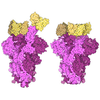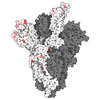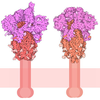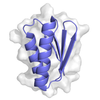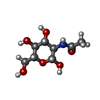+ Open data
Open data
- Basic information
Basic information
| Entry | Database: PDB / ID: 8xyh | |||||||||||||||||||||||||||
|---|---|---|---|---|---|---|---|---|---|---|---|---|---|---|---|---|---|---|---|---|---|---|---|---|---|---|---|---|
| Title | Cryo-EM structure of BANAL-20-52 spike protein (6P) | |||||||||||||||||||||||||||
 Components Components | Spike glycoprotein | |||||||||||||||||||||||||||
 Keywords Keywords | VIRAL PROTEIN / BANAL-20-52 / spike protein | |||||||||||||||||||||||||||
| Function / homology |  Function and homology information Function and homology informationsymbiont-mediated disruption of host tissue / Maturation of spike protein / Translation of Structural Proteins / Virion Assembly and Release / host cell surface / host extracellular space / viral translation / symbiont-mediated-mediated suppression of host tetherin activity / Induction of Cell-Cell Fusion / structural constituent of virion ...symbiont-mediated disruption of host tissue / Maturation of spike protein / Translation of Structural Proteins / Virion Assembly and Release / host cell surface / host extracellular space / viral translation / symbiont-mediated-mediated suppression of host tetherin activity / Induction of Cell-Cell Fusion / structural constituent of virion / entry receptor-mediated virion attachment to host cell / membrane fusion / Attachment and Entry / host cell endoplasmic reticulum-Golgi intermediate compartment membrane / positive regulation of viral entry into host cell / receptor-mediated virion attachment to host cell / host cell surface receptor binding / symbiont-mediated suppression of host innate immune response / receptor ligand activity / endocytosis involved in viral entry into host cell / fusion of virus membrane with host plasma membrane / fusion of virus membrane with host endosome membrane / viral envelope / symbiont entry into host cell / virion attachment to host cell / SARS-CoV-2 activates/modulates innate and adaptive immune responses / host cell plasma membrane / virion membrane / identical protein binding / membrane / plasma membrane Similarity search - Function | |||||||||||||||||||||||||||
| Biological species |  Coronavirinae (virus) Coronavirinae (virus) | |||||||||||||||||||||||||||
| Method | ELECTRON MICROSCOPY / single particle reconstruction / cryo EM / Resolution: 2.5 Å | |||||||||||||||||||||||||||
 Authors Authors | Xu, Z.P. / Li, L.J. / Gu, Y.H. / Qi, J.X. / Gao, G.F. | |||||||||||||||||||||||||||
| Funding support |  China, 1items China, 1items
| |||||||||||||||||||||||||||
 Citation Citation |  Journal: J Virol / Year: 2025 Journal: J Virol / Year: 2025Title: CX1/BtSY2 and BANAL-20-52 exhibit broader receptor binding and higher affinities to multiple animal ACE2 orthologs than SARS-CoV-2 prototype. Authors: Zepeng Xu / Linjie Li / Yuhang Gu / Dedong Li / Jianxun Qi / Kefang Liu / Chu-Xia Deng / George Fu Gao /  Abstract: Animal coronaviruses (CoVs) CX1 (formerly named BtSY2) and BANAL-20-52 are phylogenetically closely related to severe acute respiratory syndrome coronavirus 2 (SARS-CoV-2), and CX1 is the first ...Animal coronaviruses (CoVs) CX1 (formerly named BtSY2) and BANAL-20-52 are phylogenetically closely related to severe acute respiratory syndrome coronavirus 2 (SARS-CoV-2), and CX1 is the first observed animal betaCoV carrying naturally occurring Y501 in its receptor-binding domain (RBD) of the spike (S) protein, a residue related to human adaptation and broader host range. We evaluated the ACE2 usage of CX1 and BANAL-20-52 and observed broader receptor binding spectra and higher affinities to most of the tested animal ACE2 orthologs than the SARS-CoV-2 prototype. Determination of the cryo-EM structures of their S proteins and RBD/hACE2 complexes reveals that Y501 is inter-replaceable with H498 substitution while synergetic with R498 for human ACE2 binding. These results provide further structural insights into SARS-CoV-2 receptor recognition and address the importance of surveillance on potential emerging CoVs.IMPORTANCESince the outbreak of COVID-19, forewarning and prevention of the next pandemic have been widely discussed. Coronaviruses (CoVs) CX1 (formerly named BtSY2) and BANAL-20-52 are phylogenetically closely related to SARS-CoV-2. Particularly, CX1 is the first SARS-CoV-2-related CoV containing Y501 in its receptor-binding domain (RBD) of the spike (S) protein. This study evaluated the interspecies transmission potential of the two CoVs and structurally elucidated the interplay between two RBD residues 498 and 501 on ACE2 binding, further highlighting the importance of surveillance on zoonotic CoVs. | |||||||||||||||||||||||||||
| History |
|
- Structure visualization
Structure visualization
| Structure viewer | Molecule:  Molmil Molmil Jmol/JSmol Jmol/JSmol |
|---|
- Downloads & links
Downloads & links
- Download
Download
| PDBx/mmCIF format |  8xyh.cif.gz 8xyh.cif.gz | 652.7 KB | Display |  PDBx/mmCIF format PDBx/mmCIF format |
|---|---|---|---|---|
| PDB format |  pdb8xyh.ent.gz pdb8xyh.ent.gz | 529.4 KB | Display |  PDB format PDB format |
| PDBx/mmJSON format |  8xyh.json.gz 8xyh.json.gz | Tree view |  PDBx/mmJSON format PDBx/mmJSON format | |
| Others |  Other downloads Other downloads |
-Validation report
| Summary document |  8xyh_validation.pdf.gz 8xyh_validation.pdf.gz | 2.6 MB | Display |  wwPDB validaton report wwPDB validaton report |
|---|---|---|---|---|
| Full document |  8xyh_full_validation.pdf.gz 8xyh_full_validation.pdf.gz | 2.7 MB | Display | |
| Data in XML |  8xyh_validation.xml.gz 8xyh_validation.xml.gz | 96.2 KB | Display | |
| Data in CIF |  8xyh_validation.cif.gz 8xyh_validation.cif.gz | 144.9 KB | Display | |
| Arichive directory |  https://data.pdbj.org/pub/pdb/validation_reports/xy/8xyh https://data.pdbj.org/pub/pdb/validation_reports/xy/8xyh ftp://data.pdbj.org/pub/pdb/validation_reports/xy/8xyh ftp://data.pdbj.org/pub/pdb/validation_reports/xy/8xyh | HTTPS FTP |
-Related structure data
| Related structure data | 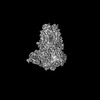 38773MC  8xymC  8xyoC M: map data used to model this data C: citing same article ( |
|---|---|
| Similar structure data | Similarity search - Function & homology  F&H Search F&H Search |
- Links
Links
- Assembly
Assembly
| Deposited unit | 
|
|---|---|
| 1 |
|
- Components
Components
| #1: Protein | Mass: 141729.734 Da / Num. of mol.: 3 / Mutation: F817P, A892P, A899P, A942P, K986P, V987P Source method: isolated from a genetically manipulated source Source: (gene. exp.)  Coronavirinae (virus) / Gene: S, 2 / Variant: BANAL-20-52 / Production host: Coronavirinae (virus) / Gene: S, 2 / Variant: BANAL-20-52 / Production host:  Homo sapiens (human) / References: UniProt: P0DTC2 Homo sapiens (human) / References: UniProt: P0DTC2#2: Polysaccharide | Source method: isolated from a genetically manipulated source #3: Sugar | ChemComp-NAG / #4: Chemical | Has ligand of interest | Y | Has protein modification | Y | |
|---|
-Experimental details
-Experiment
| Experiment | Method: ELECTRON MICROSCOPY |
|---|---|
| EM experiment | Aggregation state: PARTICLE / 3D reconstruction method: single particle reconstruction |
- Sample preparation
Sample preparation
| Component | Name: BANAL-20-52 spike protein (6P) / Type: COMPLEX / Entity ID: #1 / Source: RECOMBINANT |
|---|---|
| Source (natural) | Organism:  Coronavirinae (virus) Coronavirinae (virus) |
| Source (recombinant) | Organism:  Homo sapiens (human) Homo sapiens (human) |
| Buffer solution | pH: 8 |
| Specimen | Embedding applied: NO / Shadowing applied: NO / Staining applied: NO / Vitrification applied: YES |
| Vitrification | Cryogen name: ETHANE |
- Electron microscopy imaging
Electron microscopy imaging
| Experimental equipment |  Model: Titan Krios / Image courtesy: FEI Company |
|---|---|
| Microscopy | Model: FEI TITAN KRIOS |
| Electron gun | Electron source:  FIELD EMISSION GUN / Accelerating voltage: 300 kV / Illumination mode: FLOOD BEAM FIELD EMISSION GUN / Accelerating voltage: 300 kV / Illumination mode: FLOOD BEAM |
| Electron lens | Mode: BRIGHT FIELD / Nominal defocus max: 2000 nm / Nominal defocus min: 1000 nm |
| Image recording | Electron dose: 60 e/Å2 / Film or detector model: GATAN K3 (6k x 4k) |
- Processing
Processing
| EM software | Name: PHENIX / Version: 1.20.1_4487: / Category: model refinement | ||||||||||||||||||||||||
|---|---|---|---|---|---|---|---|---|---|---|---|---|---|---|---|---|---|---|---|---|---|---|---|---|---|
| CTF correction | Type: PHASE FLIPPING AND AMPLITUDE CORRECTION | ||||||||||||||||||||||||
| 3D reconstruction | Resolution: 2.5 Å / Resolution method: FSC 0.143 CUT-OFF / Num. of particles: 253926 / Symmetry type: POINT | ||||||||||||||||||||||||
| Refine LS restraints |
|
 Movie
Movie Controller
Controller



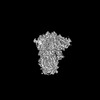

 PDBj
PDBj